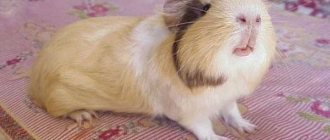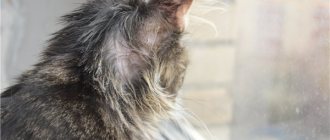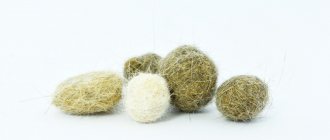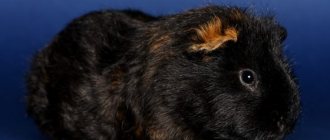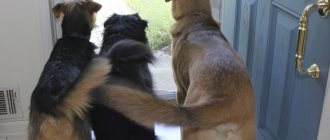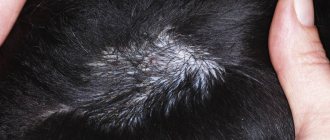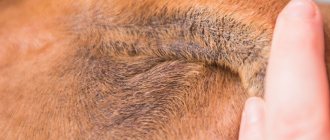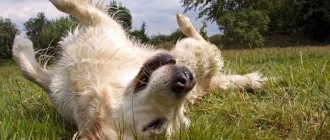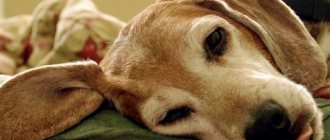Can baldness be related to the age of the animal?
Yes, although some problems occur at a certain age. For example, puppies are prone to infectious diseases or skin viruses that cause thinning of the coat. The immune system of the growing body copes better with infections that an adult may not notice. One of the reasons for hair loss in mature individuals is excessive change of coat. An adult animal may be prone to allergies or seasonal molting. This is in contrast to a senior dog who experiences alopecia due to medical conditions such as hypothyroidism or Cushing's disease. To determine what caused the problem, you need to understand how hair grows in canines. Each hair has a certain growth duration. When it ends, the hair leaves the follicle. And if the process of shedding occurs faster than the growth of new hair, then this leads to bald spots on the animal’s body.
Identifying the root of the problem will answer two questions: why dog hair falls out and why it is replaced by new hair so quickly. Answer these questions and you will immediately understand how to solve the problem.
Causes
Bald spots may appear on a dog's body and head for one of the following reasons:
- Irrational feeding . Lack of vitamins, minerals, and proteins can cause focal hair loss.
- Mechanical damage to the skin (trauma, injection, burn, bite, abrasion).
- Pyoderma . The disease is caused by coccal flora and is contagious. The primary symptom is the appearance of round red lesions with purulent rashes framed by scales. Later, these places become overgrown with crust and become bald, the skin on them darkens and becomes rough. Bacterial infection of the deep layers of the epidermis contributes to the formation of fistulas and abscesses.
- Demodicosis . A parasitic skin disease that causes focal hair loss, accompanied by skin hyperemia, itching, peeling of scales, and sometimes bleeding. Most often, a bald spot appears on a dog’s paw or in the muzzle area. A severe drop in immunity can cause a generalized form of demodicosis, in which most of the body is affected. The severe form is accompanied by loss of appetite and a drop in temperature.
- Dermatomyositis . The inflammatory process of the skin and muscle tissue is caused by disruptions in the immune system. Breeds with hard coats are most susceptible. The initial symptom is the appearance of nodules, which subsequently burst, become crusty and go bald. The main affected areas are the nose, ears, limbs, and the area around the eyes. Muscle damage manifests itself as difficulty moving, chewing and swallowing food.
- Dermatophytosis (ringworm). Its symptoms are round, inflamed areas covered with a crust, the hair on which breaks off, as if it had been cut. Ringworm in dogs occurs with pronounced symptoms and is very difficult not to notice.
- Autoimmune alopecia. Bald patches of round shape appear on the body, not accompanied by itching.
- Sarcoptic mange (scabies). Hairless lesions most often form on the ears, but can affect other parts as well. The itching is so severe that the dog bites into the fur.
- Follicular dysplasia. A hereditary disease in which the structure of the coat changes, hair follicles are destroyed, and a bald spot appears on the dog’s back, less often on the stomach and limbs.
- Allergic reaction . Occurs from the bites of ectoparasites, food products, chemicals, drugs, plants, and is manifested by itching and rash, focal hair loss.
- Atopic dermatitis. The disease is transmitted genetically, exacerbations occur as a reaction to an allergen (pollen, dust, tick bite, fungi, proteins). It affects the face, groin and axillary area, and the space between the fingers.
- Hormonal disorders . In this case, the dog will have several symmetrically located bald spots on its body. A bald spot on a dog’s belly can occur during hormonal fluctuations during pregnancy, lactation and diseases of the reproductive organs.
Types of alopecia
Today in veterinary medicine there is no unified classification system that would clearly describe the types of diseases. The difficulty lies in multiple symptoms, often mixed with another disease. But there are two main groups of alopecia:
- by etymology: inflammatory and non-inflammatory;
- by origin: congenital and acquired;
- by localization: symmetrically bilateral (telogen or mirror), multifocal and focal (clustered).
Baldness can be congenital, and it may depend on the color of the dog. This phenomenon is called "discoloration alopecia." It is found in breeds such as Great Dane, Dachshund, Whippet, Greyhound, Yorkshire Terrier, and Doberman. The pathology affects blue (weakened black) as well as yellow-brown coat colors. Damage to hair follicles in bleached areas usually occurs from 6 months of age.
The hereditary anomaly of black hair dystrophy is a phenomenon characteristic of breeds such as collie, beagle, basset hound, and pointer. This form of congenital alopecia affects the tricolor color. It manifests itself in brittleness and loss of dark hair, starting from the age of 4 months.
But there is also a form of congenital alopecia that is not related to coat color. Well-known representatives are the Chinese Crested and Mexican Hairless Dogs. But different breeds are susceptible to this pathology. Puppies are born with normal characteristics, but at the age of 1-4 years they begin to go bald.
Bald spots first form on the sides, then move to the back. The breeds most prone to the anomaly are: American Cocker Spaniel, Rottweiler, Doberman, Poodle, Whippet, Belgian Shepherd, Labrador Retriever, Beagle.
Doctors also use the term “alopecia X,” which means a pathology with unknown root causes. Often it is not possible to determine the source of the disease.
Excessive shedding or baldness?
First, determine: is the dog losing fur due to health problems or is it excessive shedding?
During the period of changing the “fur coat”, hair falls out evenly from the entire body. There are no bald marks left on the body, and there is no skin soreness. You can try brushing your dog daily for two weeks. This will speed up the change of coat and you can make sure that the pet is healthy. However, if the fur falls out in clumps and the skin in this area peels off, this is not normal. Especially when the skin on the damaged area is inflamed and hair growth is not observed.
Other signs that should make you wary: hair is falling out in large clumps and scabs are visible on the skin.
Remember, alopecia in animals is only a symptom. To help, you need to diagnose and identify the source of the disease.
Questions to answer:
- Does the wool fall out in clumps and leave scabs behind, or evenly throughout the entire coat?
- Is the dog itching or not?
- Does this happen in other animals at home?
- Has your pet had similar problems before or not?
- Are there other symptoms: thirst, lethargy, weight loss or gain?
The answers to these questions will help the veterinarian determine the nature of the disease: infectious, seasonal, or the cause lies in a malfunction in the pet’s body.
What is it, how does the pathology manifest itself?
The term "alopecia" refers to baldness. This pathology can be caused by many factors, the most common of which are: food allergies, the action of irritating and toxic substances, and massive flea infestation. It should be noted that in veterinary practice there are often cases when the real root cause cannot be identified. This is “alopecia X”. In dogs, experts suggest, it may be caused by an excess of sex hormones in the body.
It can be cured... but in most cases you have to resort to castration or sterilization. However, the treatment of alopecia in dogs with melanin (more precisely, melatonin) is also used. Unfortunately, even surgery does not always help with this “secret alopecia.” But you shouldn’t despair: besides baldness, which does not pose any danger to the dog’s health, this disease has no other side effects.
Accordingly, alopecia manifests itself quite simply: the animal suddenly or gradually begins to lose hair. It can be massive and focal (alopecia areata in dogs), one- and two-sided. Note that baldness is never an independent “disease”, since this phenomenon in almost all cases indicates some serious pathology. Once the underlying disease is cured, the fur will gradually grow back on its own.
What to do if your dog is losing hair
If the cause of hair loss is hormonal imbalance, follow your veterinarian's instructions.
Hypothyroidism is treated with daily parenteral administration of synthetic analogues of Thyroxine. Dwarfism is incurable. Excessive secretion of adrenal hormone (Cushing's syndrome) is eliminated surgically if the gland is affected by a tumor. For conservative treatment, the following drugs are used:
- Ketoconazole;
- Vetoril;
- Lysodren.
Ketoconazole is an antifungal drug that inhibits the synthesis of steroids.
Antifungal agent Ketoconazole
One tablet is designed for a 20 kg dog. Packaging price 130 rub.
Excess and deficiency of estrogen can be treated through castration.
If your dog's hair loss is due to non-hormonal diseases, after diagnosis you can treat your pet yourself:
- To eliminate fleas, lice, lice, use the following products:
- insecticidal emulsions;
- drops on the withers (our rating of drops against fleas and ticks);
- aerosols;
- flea collars. Aerosols are convenient to use. True, licking should not be allowed until the working solution has dried. Therefore, for 20-30 minutes, close the dog’s jaws using ribbons or put on an Elizabethan collar. If you find tangles, get rid of them using special shampoos. Spray Bars FortePrice - 240 rub.
- Treatment of dermatitis caused by subcutaneous mites is carried out in two directions:
- destruction of the parasite;
symptomatic treatment.
- Treatment of microsporia is aimed at destroying the fungus and eliminating complications. If isolated bald patches are detected, use fungicidal agents in the form of ointments or aerosols. For large-scale skin lesions, seek veterinary help. Tablets for the treatment of fungal diseases are effective, but have side effects. Aerosol - Fungin forte. The spray is sprayed over the affected areas twice a day. The course of treatment is 15 days. Price - 350 rub. Choose a drug for immune correction after consulting with your veterinarian. To speed up the healing of damaged skin, I recommend switching your pet to Purina DRM (100 rubles/1.5 kg), Eukanuba Dermatosis (1500 rubles/2.5 kg) or Hills d/d (1700 rubles/2 kg) for treatment skin diseases of any etiology.
- Bacterial infections develop when the immune system is weakened and in most cases are secondary. Treatment consists of mechanical cleaning of the affected surface followed by treatment with antiseptics. I recommend Terramycin spray. Terramycin. Price - 490 rub.
- Prevent stressful situations by taking Stop-Stress tablets or drops. Drops Stop Stress. Price 213 rub.
- The instructions for use recommend pouring the drug into the mouth with a small amount of treats 3-5 days before an event that can cause a stressful condition. After the event, the medication is extended for 4 days. A dog weighing 20 kg will require 1 ml/day.
- In case of allergic conditions, interrupt contact with the irritant. Use antihistamines as prescribed by your doctor. For emergency cases, when it comes to saving life, keep an ampoule of Dexamethasone with you (pack of 10 ampoules of 1 ml - 70 rubles). For a dog of average weight, 0.5 cm3 is administered intramuscularly or subcutaneously. The risk of losing your pet is high. If we are talking about food allergies, switch your pet to hypoallergenic food. I recommend Hills z/d. Hills z/d. Price 3 kg - 2300 rub.
- Hypovitaminosis. Vitamin supplements for dogs should be handled with care. Switch from natural food to any ready-made food of premium class or higher. Your dog will not have hypovitaminosis or hypervitaminosis.
- In case of poisoning, seek veterinary help and follow the instructions of a specialist.
- To get rid of flies on your ears, lubricate the affected tips with tar. Avoid natural food and use ready-made food of at least premium class.
- To prevent your pet from suffering from excessive grooming, remember that this is a living dog, not a doll. Refuse to wear clothes, do not bathe your pet with detergents unless necessary, and exercise moderation in your efforts to make your dog beautiful.
Demodicosis is the most difficult to treat because symptoms appear in the later stages of the disease. When using tablets, the course of treatment lasts for months. Injectable drugs are effective, but have side effects. Therefore, use external remedies, for example, Amit-Forte.
Amit-forte
Price - 220 rub.
Treat affected surfaces with strips of healthy skin 1-2 cm wide. Repeat treatments at intervals of 5-7 days, 2-5 times until recovery. The eggs are immune to the acaricide, and the larvae must be eliminated before reaching sexual maturity.
At the same time, carry out detoxification therapy and inject Gamavit. To alleviate the general condition and provide vitamins, you will need to transfer your pet to the Purina DRM therapeutic food.
Purina DRM Dermatosis
Price for 1.5 kg - 1000 rub.
Symptoms of alopecia in dogs
Each type of alopecia has its own characteristics, and there is no single clinical symptomatology. Depending on the cause and type of hair loss, dogs suffer from the following symptoms:
- Baldness due to hormonal imbalance is characterized by uniform or focal hair loss, as well as hyperpigmentation (Alopecia X).
- Seasonal shedding is characterized by uniform thinning and hair loss, but not completely.
- An unbalanced diet leads to alopecia in the form of severe thinning of the coat.
- After grooming, the symptom will be that the coat does not recover for a month.
- Allergies are characterized by alopecia areata, sores and redness in areas of baldness.
- Parasitic baldness manifests itself focally, the dog makes bald patches by scratching.
- Stress baldness is characterized by uniform loss and thinning of a dog's hair.
- During pregnancy, hair falls out evenly and the hair becomes thin. After childbirth, the fur is gradually restored.
Differential diagnosis based on the symptoms of alopecia is impossible; to determine the causes and type of disease, you need to contact a veterinary clinic where research will be carried out.
Preventing hair loss in dogs
To prevent hair loss in dogs, first of all, you need to monitor and take care of your pet’s health and its mental balance.
Regularly examine your pet, care for its fur, and take preventive measures against parasites. Pay attention to the quality and diet of the foods you feed your dog. After all, only a healthy animal, with a strong immune system and a stable psyche, will become the owner of thick and silky hair.
Good luck and take care of your pets!
The dog's hair falls out and its skin peels off. What could be the reasons?
This broad problem can have multiple sources.
Heredity
Although rare, the Pomeranian breed (Pomeranian) suffers from a genetic condition that causes hair loss called Alopecia X. In this case, X means no answer to the cause of the disease.
Allergic dermatitis
Allergies can be to the environment or to food. Itchy skin is a common symptom. Excessive licking or scratching can lead to thinning of the coat.
Folliculitis
The infection penetrates under the hair, damages the follicle and leads to hair loss. It could be a bacteria (that got on the skin along with dirt), for example, a fungal infection, ringworm. It can cause your dog to go bald.
Inflammations on the skin
Infected areas of the skin may have a sticky discharge. Similar to folliculitis, the bulb is damaged and bald patches form.
Parasites
Fleas, lice, and scabies mites cause itching and hair loss. Demodex mites, known as iron mites, cause bald spots on the skin that become inflamed and itchy. Demodicosis is common in puppies. Their immune system cannot recognize the mite that is hiding in the hair follicles.
Hidden problems in the body
The problem of unhealthy shedding can occur due to other reasons. In conditions of passive thyroid glands (hypothyroidism disease) or Cushing's disease, the animal is susceptible to fur loss and the formation of hairless patches. Those who suffer from this disease also experience thirst, changes in appetite and weight, and lethargy.
Seasonal molt
Seasonal fur change is a natural phenomenon in animals. During this period, they tend to gradually shed their “fur coat” from the entire cover. The process may be minor and unnoticeable, other than you may notice too much dog hair in the corners. Fur, as a rule, is renewed with the change of season.
Hair loss around the eyes
The stage of balding around the eyes can be caused by demodex mites. In this case, you need to seek help from a veterinarian as soon as possible. Under no circumstances should the disease be allowed to spread to the animal’s eyes!
Hair falls out on the back and stomach
It is impossible to say where alopecia may appear. Like any other part of the body, the stomach, back, and tail can be susceptible to alopecia for various reasons. An animal can pick up a tick or other parasite while walking. Or there may be other reasons for this.
In fact, it doesn’t matter where the pet’s bald patches appear. It is important to seek help from a specialist as soon as possible.
Poor diet for your pet
Most often, baldness in a dog indicates that the animal is not being fed correctly. Your pet's diet is lacking in vitamins, minerals or other nutrients. Also, the cause of baldness is feeding the dog with cheap industrial food, which contains large quantities of flavor enhancers, dyes and preservatives.
If your pet's baldness is associated with poor feeding, it is necessary to balance the diet and add vitamin supplements to it.
Problems with hormones
According to the latest data from veterinary scientists, it has been established that hormonal hair loss in dogs is associated with genetic problems. The official name of the disease Alopecia X means that the mechanisms of development of problems and transmission through genes are not fully understood. Today, transmission through an autosomal dominant relationship is considered the most likely.
Most often, adult and elderly dogs suffer from endocrine alopecia.
Hormonal problems can be caused not only by hereditary factors, but also by acquired ones. The most common causes of hormonal problems that cause baldness are diseases such as hypothyroidism and hyperandrenocorticism. In the first case, alopecia develops due to insufficient production of thyroid hormones, in the second - increased levels of cortisol (Cushing's syndrome).
Most often, the endocrine nature of alopecia leads to baldness on the abdomen and hind limbs, chest, anus and genital area, and armpit.
Stress
Dogs, like people, can experience stress; Chihuahuas and Labradors are most susceptible to such disorders. As a result of stressful situations, the animal's body experiences a multicomponent reaction in response to severe stress. Scientists have proven that this condition of the animal can lead to hair loss, among other things (Yang EV, Glaser R., 2001). The causes of stress are:
- Moving.
- First visit to exhibitions and competitions.
- Aggression from humans or other dogs.
As a result of stressful situations, the mildest form of alopecia develops - diffuse. Symptoms of the disease may not be noticeable and everything will return to normal on its own. Complications can arise if the pet experiences stress very often.
Pregnancy
The period of gestation of puppies itself does not cause baldness. Pregnancy entails a lack of vitamins in the pet’s body, hormonal imbalances and stress. During this special period, the cause of baldness may be one of the factors or all together.
To avoid alopecia in a dog during pregnancy, you need to improve the animal’s nutrition and ensure a quiet life, without unnecessary stress and close attention, especially from children.
Non-hormonal causes of hair loss in dogs
Seasonal or age-related shedding
This is a completely natural phenomenon and should not cause any concern to the dog owner.
During seasonal molting, the animal's hair falls out evenly throughout its body. If the hair falls out in clumps, and moreover, redness or itching appears at the site of the loss, then this already indicates serious health problems.
Normal heavy shedding occurs in a healthy pet once or twice a year (usually in spring and autumn). Older dogs may shed more frequently. Autumn shedding lasts longer, but it produces less fur.
Seasonal molting continues for about 3-4 weeks. The extent of shedding also depends on the breed, coat type and age of the animal. During the period of such molts, it is necessary to more carefully care for the animal’s fur, combing it using combs and furminators. If this is not done, then in dogs (especially with long, thick hair), the lost hair may not fall off, but become entangled in the “living” hair. As a result, tangles form, which are then impossible to comb and have to be cut off.
There is an opinion that smooth-haired and short-haired dogs have much less hair than dogs with long and thick hair. But this is a huge misconception. And I know this firsthand. As the owner of a smooth-haired Jack Russell terrier, I can tell you for sure that the opposite is true. During the molting period, there is no less fur from it, but even more. How so, why? - you ask. The answer to this question can be found in the article: Jack Russell Terrier Coat.
Seasonal shedding does not in any way affect the animal’s well-being, while hair loss caused by any disease is often accompanied by additional symptoms, such as lethargy, lack of appetite, itching, and so on.
Passion for clothes
The next important reason for hair loss in four-legged animals is the obsession with dog clothes. Showing concern for their pet, some dog owners try in every possible way to protect it from natural influences (rain, snow, sun). To protect the animal from the elements, they dress it in a variety of dog clothes.
I must say that recently many varieties of dog clothes have appeared in stores. What is not on sale: vests, caps, boots, overalls for all seasons (warmer and colder), suits for everyday wear, suits for a festive occasion and much, much more. And everything is so cool, everything is so beautiful. How can you not resist and buy your pet a beautiful outfit?
Owners of small breeds are especially prone to such dressing up. But of course, in a beautiful suit a little dog will look even cuter, funnier and funnier. Everyone around him will admire and admire him.
Very often we forget that a dog is a descendant of a wolf. And our pets don’t need all these outfits at all. First of all, we need this.
The dog's body is designed in such a way that it can tolerate both heat and cold. And by once again “bundling” our little tail, we only ensure that the animal’s body stops independently developing immunity to all temperature changes and the pet begins to get sick.
Of course, all our dogs are already fully domesticated. It is possible, and even necessary, to protect the animal from rain and frost. But this should only be done in exceptional cases.
Dogs can easily walk in the rain without clothes. And in winter they should only be worn in severe frosts.
Stress
Like humans, the domestic dog is a resident of large cities. And it is quite natural that from time to time an animal may experience stress and shock from external factors. Fireworks, moving, changing owners, and even a visit to the veterinarian can cause extreme stress and, as a result, hair loss.
What can we say about animals that, after living for many years with people, end up on the street (get lost, or simply turn out to be unnecessary).
Cosmetical tools
Unplanned shedding can be triggered by certain cosmetics that dog owners use when bathing.
Frequent bathing
Another reason why a dog's hair falls out is frequent bathing of the animal. Frequent washing leads to the fact that the four-legged fur becomes thinner and brittle. And the constant washing out of the sebaceous glands from the skin can lead to the fact that the hair follicles simply cannot stay in the hair follicles and fall out.
It is recommended to bathe your dog no more than once every 1.5-2 months (except, of course, in unforeseen situations). The water temperature should be slightly warm. Every day, after a walk, you should only wash your paws and pussy-butt. You can read more about bathing rules in the article: How to wash a dog.
Allergy
Very often, the cause of hair loss is allergies. Allergies can be food or non-food.
Food allergies can manifest themselves during the selection of an animal’s diet. Moreover, it does not matter at all whether the food is dry or natural. Allergies can be both to dry food and to certain types of natural feeding products. There are often cases when a pet’s body, over time, begins to react even to food or products that it has been eating for many years.
Non-food allergies can occur to certain types of medications, detergents and cosmetics.
The first signs of an allergy are redness of the most sensitive areas of the skin (ears, abdomen, armpits, mucous membranes of the eyes and mouth), swelling of individual parts of the body, the appearance of itching, rashes, and then bald spots. There should be no sores or ulcers due to allergies (of course, if the tail does not scratch the itchy parts of the body into the blood).
Lack of vitamins
A lack of vitamins in an animal’s body can also lead to excessive hair loss, because the pet does not always receive all the necessary microelements from food. But remember, under no circumstances should you get carried away with fortification. An excess of vitamins is no less, and even more dangerous, than their deficiency.
Parasites
Another cause of hair loss in dogs can be parasites that live both on the skin and in the animal’s body. Lice eaters, ticks, fleas, helminths.
When a pet is infected with parasites, the hair no longer falls out evenly throughout the body, but in shreds. Severe itching and sores appear. The animal is unable to tolerate this unbearable itching and scratches the wounds until they bleed, tearing out the fur along with the sores. Bald spots can reach several centimeters in diameter.
A very dangerous pathogen is the subcutaneous scabies mite, which causes a disease such as demodicosis in dogs.
With demodicosis, the areas of the lips, eyelids, hind limbs, and abdomen are most susceptible to baldness. The subcutaneous mite multiplies at an incredible speed, and if treatment is not started in time, the dog may simply die in agony.
Very often, young animals whose bodies are still very weak become ill with demodicosis. This disease is parasitic, and if your pet has a weakened immune system for one reason or another, then the likelihood of becoming infected with this scabies mite is very high.
Ringworm
Ringworm or trichophytosis is a very dangerous disease that is transmitted from animals to humans. The causative agent of this disease is microspores (fungal infections).
The first sign of ringworm is red patches and broken hair. At the first manifestations of this disease, you should urgently contact a veterinary clinic, as the whole family can become infected with this infection.
Acanthosis nigricans
Signs of this disease are: excessive hair loss, the appearance of pigmentation on the skin, and sometimes growths and papillomas. The lesions are predominantly concentrated in the armpits, groin, ears and neck. First, the skin turns brown and becomes dry. Over time, it begins to turn black, and various growths and folds appear.
Incorrect conditions of detention
Poor ventilation and temperature changes (heating and air conditioning) can lead to dry and flaky skin, dull color and brittle hair.
The dog is going bald for no apparent reason
A dog sometimes goes bald for no apparent reason. This may occur due to hormonal imbalance, stress or hereditary predisposition.
- Hormonal disorders Hair loss in dogs is caused by Cushing's syndrome, a lack or excess of estrogen, and a lack of thyroid hormone.
- Stress If your pet is constantly worried or exposed to stress for a long time, then he may experience hair loss. After eliminating the source of stress, the pet’s fur will grow back after some time.
- Hereditary predisposition Some dog breeds are prone to hair loss. These include the Chihuahua, Poodle, Miniature Pinscher, and Pomeranian. With baldness caused by hereditary factors, hair falls out on the body and thighs, but remains on the head and paws. At the same time, the dog looks healthy in appearance, does not experience itching, and there is no peeling or redness on the skin.
Hormonal causes of hair loss in dogs
There can be many hormonal reasons for your furry friend's baldness. Let's talk about the most common of them.
Hypothyroidism
Hypothyroidism is a deficiency of thyroid hormones. The disease can be either congenital or acquired.
The main function of thyroid hormones is to control basic metabolism. And since the functioning of the thyroid gland is disrupted, the functioning of all organs and systems of the animal’s body is disrupted.
The main signs of this disease are: reproductive disorders, damage to the cardiovascular system, eye damage, hair loss. Hair loss primarily occurs on the back and sides of the animal. Also affected are areas subject to maximum friction: the neck area under the collar, the groin area, and the armpits. In this case, no signs of scratching are observed.
Cushing's syndrome
Cushing's syndrome is a disease in which the pituitary gland (an appendage of the brain that produces hormones that affect growth, metabolism, etc.) begins to secrete cortisol (a hormone that helps withstand stress) at double the rate.
So that's good! - many will say. But no. The amount of cortisol that enters the blood during Cushing's syndrome is so extreme that, most likely, it would be enough not for a dog, but for an entire elephant. Therefore, an excessive amount of cortisol in an animal’s body causes serious disturbances in its body.
In addition to excessive hair loss, deviations such as serious behavioral and mental disorders, excessive thirst and urination are observed. The animal begins to eat a lot, but at the same time practically does not gain weight, but only sagging belly.
Excess or lack of estrogen (hyperestrogenism or hypoestrogenism)
Estrogens are the general name for sex hormones that are produced in the body of animals of both sexes. And the first sign of a violation of the level of estradiol in the body is thinning or loss of hair in animals specifically in the genital area.
Diagnosis of the disease
Some diseases make themselves felt immediately. But there are also those that are not always accompanied by symptoms. The veterinarian must examine the dog, study the history and nature of the disease. You may need to take some tests:
- Viral blood test: will identify specific germs or bodies that are causing your pet's allergies.
- Skin scraping: to detect possible parasites on the skin
- Cytology: the study of cells present on the surface of the skin
- Skin biopsy and histology: examination of skin cells from the inside
- Complete blood count: to identify possible diseases
The answers to one or more tests will give you a picture of the disease.
Best Treatments
Based on the diagnostic results, the veterinarian must prescribe appropriate treatment for the dog. There are general recommendations that are aimed at stimulating hair growth in dogs:
- Give the dog stimulating vitamins (Velkot, Polidex Super Wool);
- Increase the frequency of bathing your pet up to once a week;
- Masks of castor and burdock oil with egg yolks.
You should not give your dog human medications to stimulate hair growth (such as Minoxidil). The consequences of using such drugs can lead to the death of the animal.
After poor nutrition
Alopecia after an unbalanced diet requires a gradual increase in nutrients in the diet. Veterinarians recommend starting to give your dog fish oil, dairy products, seafood, and adding olive and flaxseed oil to his food. Vitamin complexes containing vitamin A can also be prescribed.
Treatment of hereditary hormonal alopecia
A genetic predisposition to baldness is formed due to hormonal problems. Therapy is carried out accordingly with hormones. The effectiveness of this therapy is low, so it is used in combination with the use of hair growth stimulating agents.
Contact or food dermatitis
This type of alopecia has an allergic etiology and side effects. It is treated with a complex of drugs prescribed by a veterinarian:
- Antihistamines (Diazolin, Diphenhydramine, Suprastin);
- Antiseptic ointments (Ranosan, Saphroderm, Septogel);
- Eliminating the allergen.
The use of such a complex of therapeutic measures helps eliminate the symptoms of baldness after 2-3 weeks. In advanced cases, independent treatment is impossible; the dog remains in the hospital.
Treatment for hair loss due to infection
The treatment regimen depends entirely on the type of infection that led to baldness. First of all, treatment is aimed at eliminating foreign bacteria, fungi and viruses from the body. Treatment is carried out with antiviral drugs.
Therapy for baldness from parasites
Treatment is aimed at eliminating helminths from the pet’s body that cause coat problems. Antiseptics are used to eliminate itching and prevent scratching. Further treatment is carried out using antiparasitic agents for animals, bathing, and enemas.
What vitamins can help against hair loss in dogs?
Animals need periodic feeding just like people. To restore hair and skin, you need complexes including amino acids, zinc, B vitamins, as well as D, F, H.
For complete nutrition, products containing the above components are added to the feed. These are liver, flaxseed oil, whey, lamb, brewer's yeast.
If your pet refuses the necessary products, use pharmacy vitamin complexes and supplements:
- Polydex - designed to restore hair in dogs.
- Vit Active S-Sh is a drug that helps prevent allergic reactions. Contains antioxidants, softens coats.
- Hokamix Skin & Shine - intended for rubbing into itchy and flaky areas of the skin. The oil is easily absorbed, relieving unpleasant symptoms and making the coat shiny.
- Excel 8 in 1 - includes those foods that the dog will not eat. Yeast and garlic included in the composition have a positive effect on the skin.
- Laveta Super Malti (Beafar) is a special multivitamin complex.
- Kanvit Biotin - prescribed for a lack of biotin. Contained in salmon liver and meat, nuts, soybeans, wheat, cauliflower, green peas and other products. You can combine the drug with natural products.
Canina is a popular brand that offers dog owners the best selection of vitamin complexes for different ages and breeds. The preventive line examines each problem from the inside and helps the animal restore the balance of the missing elements based on their physiological characteristics. Before purchasing the drug, it is recommended to consult a veterinarian.
Preventing hair loss in dogs
Preventing your dog from going bald is quite simple. It is necessary to properly care for and maintain your pet. Observe the following rules:
- Brush regularly
- Use special shampoos and conditioners for dogs
- Make sure your pet's diet is complete
- Avoid contact with stray animals
- Treat your dog for internal and external parasites
- Vaccinate your dog promptly
- Get regular veterinary checkups
Treatment of hair loss (alopecia) in dogs
There is simply no single, universal way to treat alopecia in dogs. Hair loss can be caused by a number of diseases (the most popular of which are described above), and subsequent therapy will depend entirely on the underlying cause. Dog owners should remember that only a specialist can correctly identify the catalyst disease, so trying to diagnose the cause of alopecia at home is not only useless, but also unsafe.
To determine the disease, tests are taken. So, to determine fungal and infectious diseases, a scraping is made with a special tape.
If the cause of the symptom is a hormonal imbalance, then the dog will be prescribed hormonal medications that will quickly restore the pet’s hormonal levels and fur.
If the cause of the hair loss is parasites, then the dog is prescribed drops that destroy ticks, fleas, lice and lice. A short course of medication will help get rid of helminths. At a veterinary clinic, you may be offered to use complex preparations that allow you to get rid of all pests at once (Advocate, Stronghold). In advanced cases, your doctor may prescribe antibiotics.
If the cause is decreased immunity, immunostimulating drugs are prescribed. In the future, it is better for some time to give the dog food containing special vitamin complexes for hair growth (Kino3).
However, dog owners can try to prevent hair loss by closely monitoring their dog's diet and immune system. In order for a pet to resist various infections, its diet must contain vitamin B, as well as essential minerals and beneficial microelements. In addition, the use of “human” shampoos and conditioners in animal care is unacceptable. Such cosmetics, as well as incorrectly selected shampoos for dogs, can cause serious allergies. That is why even such a seemingly insignificant choice should be made only after consultation with a specialist.
Pet grooming
To quickly cope with this disease, it is extremely important to provide the dog with proper and complete care at home. It provides:
- Complete feeding of your pet. During the treatment period, it is recommended to give the dog food with a high content of vitamins, and to completely exclude from the menu all foods that can provoke allergies.
- Providing your pet with adequate rest and protection from stress. In case of infectious diseases, it is recommended to refrain from walking in public places and avoid contact with other animals, especially wild ones. If the dog lives in an enclosure, in a kennel, it is recommended to take him into the house and keep him there until he fully recovers.
- Use of a special protective collar. This remedy is used for severe itching to prevent the animal from scratching the skin. Effective if bald spots appear under the collar, on the face, around the eyes or ears.
- Regular brushing of your pet. Remember that fallen fur greatly irritates the skin and provokes intense shedding.
- The use of local drugs to relieve symptoms of pathology. If your doctor has not prescribed you an ointment, you can use olive oil for this purpose.
- Using special shampoos for bathing dogs. They must be selected by a veterinarian.
It is also extremely important to exclude the possibility of re-infection of the dog with parasites, pathogenic bacteria or fungi. To do this, you should treat the animal’s bedding (or replace it with a new one), its toys, bowls, and combs. The same should be done with the personal belongings of other animals living in the house.
Pregnant and lactating bitches suffering from hair loss should be provided with an enhanced diet. General medications are not used for such individuals, as they can negatively affect the development of the offspring. Sick puppies that have inflammation of the glands should be isolated from the rest of the litter. Otherwise, other babies can quickly catch an infection from them.
This type of care is provided until the dog fully recovers. After the symptoms of the disease disappear, he is again shown to the veterinarian. If he is satisfied with the condition of the animal, you can return to the normal rhythm of the animal’s life, remove restrictions on walking and choose a simpler diet for him.
Video: why does a dog lose hair, and what to do about it?
The dog's hair is falling out, going bald, and bald spots appear.
Most dog owners know that if their pet's fur begins to actively fall out several times a year, there is no need to worry - this is a process of seasonal shedding. However, if this period is still far away, and the fur begins to become thin and actively fall out, the owners of the animal should be actively concerned about its health. It is also worth remembering that seasonal shedding does not in any way affect the general well-being of the dog, while hair loss or baldness, also known as alopecia, caused by illness or serious disorders of the body, can provoke other clinical signs, including, for example, lethargy , lack of appetite.
Restoring hair around the tail
When local treatment is provided and the cause is eliminated, the hair in the tail area will need to be restored. The dog will need special vitamins and feed additives.
- Enrich your animal's diet with polyunsaturated fatty acids. For example, using vegetable oils.
- Offer your pet a spoonful of flaxseed or olive oil.
- If your pet eats natural foods, feed beef, raw liver, kidneys, and chicken eggs.
- Give the animal fish oil.
- It is allowed to add corn oil rich in vitamin E to food.
- If your four-legged friend eats factory-made food, switch to premium food.
It is permissible to give special vitamins for wool - microvit, retinol. Sulfur preparations have a good effect on wool.
Diseases associated with baldness
One of the more common causes of intense baldness is an allergy to low-quality food, medications, or household chemicals. In other cases, if a dog has a bald tail, this is a symptom of the onset of a serious illness.
Endocrine changes
The cause of intense baldness can be a hormonal imbalance. When Cushing's syndrome develops, the body produces excess amounts of cortisol, which is usually accompanied by abundant alopecia.
The appearance of bald areas of the skin is observed due to improper production of estrogen. Endocrine causes of bald spots also include a lack of growth hormone.
A large deficiency of essential hormones leads to serious disruptions in the functioning of internal organs and is often accompanied by intense baldness.
Parasitic and infectious diseases
The cause of baldness in areas of the fur in the tail area can be pyoderma - a purulent acute inflammation of the skin. Treatment is carried out using ointments and antibacterial drugs.
Worm infestations often lead to hair loss. Parasites cause severe intoxication, poisoning the animal's body with waste products, which is often accompanied by severe baldness in the area of the croup and tail.
Skin diseases cause severe itching; the animal constantly itches, thereby injuring the skin, and this is an open path for infection. Complex therapy is used for treatment.
Inflammation of the sebaceous glands
Impaired functioning of the skin often leads to clogged pores, changes in metabolic processes and the death of hair follicles.
If the tip of a dog's tail is peeling, this is the first symptom of the disease, and with inactivity, the bald spot spreads along the back, stomach and rump. Special care and regular cleaning of pores are required.
Inflamed areas of the skin are treated with hydrogen peroxide, dried and sprinkled with antiseptic powder.
In rare cases, the cause of intense baldness can be the hereditary characteristics of some breeds: Doberman, Chow Chow, Rottweiler, Terrier, and this phenomenon is called color mutation alopecia.
Diseases that cause hair loss in dogs
There are many different diseases that cause alopecia in animals. Let's look at the most common ones.
Fungal infections (mycoses). Affects mucous membranes and skin. Hair loss in dogs in a small area is the first sign. Redness, a white coating, small rashes, and blisters appear on the bald spot.- Hypothyroidism. A serious disease associated with the inaccessibility of the thyroid gland. Many metabolic processes in the body are disrupted and the level of stress hormones increases. Hair loss, swelling, lethargy are the main signs.
- Parasites. The presence of helminths in the body causes severe intoxication. The animal begins to have an allergic reaction and the skin is the first to suffer.
- Dermatitis. They are infectious, toxic and neurophysiological in nature. Neurodermatitis is especially common in small breeds of dogs. Chihuahuas often have bald ears for this very reason.
- Gastrointestinal diseases. In case of any digestive disorders, beneficial substances are absorbed worse. The body lacks nutrition and in addition to dyspeptic symptoms (belching, flatulence, vomiting), baldness, bleeding gums, weight loss, and the smell of rot from the mouth begin.
- Lack of estrogen (hyperestrogenism). Often found among spayed females. Due to a lack of the hormone, the dog’s fur becomes thinner, its growth and renewal slows down.
- Acanthosis nigricans. A skin disease caused by local accumulation of melatonin in the armpits and ears. In these places, skin dystrophy and hair loss are observed.
- Vitiligo. The disease provokes loss of pigment in the skin. The animal's head is the first to suffer.
- Adenitis of the sebaceous glands. The disease is characteristic of poodles and lapdogs. The main symptom is baldness of the face, ears, then the neck and back.
Of course, these are not all diseases that can provoke alopecia, but they are the most likely.

